[History of cinema] The greatest film of all times — Battleship Potemkin (Soviet Avant-garde)
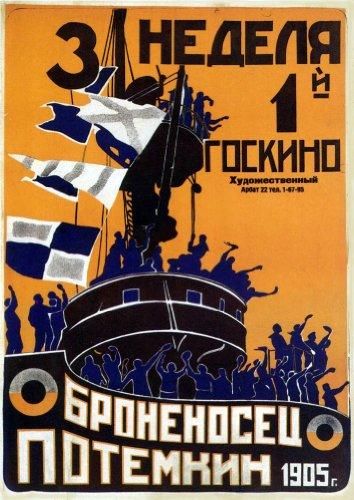
The title of this article could seem provocative. Indeed, it is impossible to declare which film among many others made during a century is the greatest one. Evaluation criteria is always subjective when we talk about arts, including movies. Also, the way cinema evolved during decades is determined by dozens of films. There are a lot of great movies which pushed the art of filmmaking beyond its borders. So we can’t define a certain film which is the best among others. Meanwhile we can admit a certain movie to be one of the most important films in history. «Battleship Potemkin» (dir. Sergey Eisenstein) definitely fits this category.
This masterpiece of Soviet «avant-garde» was repeatedly included into top-lists of the best movies. During the Brussel’s world fair in 1958 more then a hundred of film historians and critics from all over the world assembled to compose a list of the greatest films of all time. And they put «Battleship Potemkin» in the first place. In 2010 Eisenstein’s film got the third place in «The 100 Best Films Of World Cinema» list composed by Empire magazine. In 2012 The Sight and Sound magazine made Critics and Directors polls to define top-100 of the greatest films of all times. «Battleship Potyomkin» got the 11-th (According to critics opinion) and the 75-th (according to directors opinion) places.
Thus this film is definitely worth our attention. I am going to tell you the main points of its plot and share my modest analysis of its artistic features.
Background of production
«Battleship Potemkin» is based on a real event. In 1905 sailors of battleship called «Potemkin» rebelled against their officers. It wasn’t a unique occasion. A row of rebellions against tsarist government rolled through the whole Russian Empire that year. In 1925 Soviet government was about to celebrate the 20-years anniversary of so-called first Russian revolution. Young but talented film director Sergey Eisenstein was chosen to shot a movie dedicated to this celebration. At first Eisenstein conceived an epic plot showing all events of 1905 rebellions. Soon it turned out to be that anniversary date was approaching too fast so it was impossible to create a movie of such a large scale on time. Then Eisenstein decided to shot the single episode of 1905 which reflects the whole essence of those events. He had chosen the Potemkin’s revolt.
Plot
The film tells a story of a sailors rebellion. The specific feature of this film is that it has no leading hero. To be precise, there is a main character, but it is not an individual man, but the Battleship Potemkin itself and its crew. Like in antic drama, the plot of «Battleship Potemkin» is divided into five parts.
Here are these parts:
- Men and Maggots — this part introduces the crew and initiates conflict. Sailors are given for lunch a rotten meat swarmed by maggots. Then an old puny doctor appeared trying to pacify sailors indignation. After having examined the meat he said his verdict: everything is all right, there are no maggots in meat, there are dead larves of flies that could be easily washed away. The hypocrisy and indifference of system reveals itself.
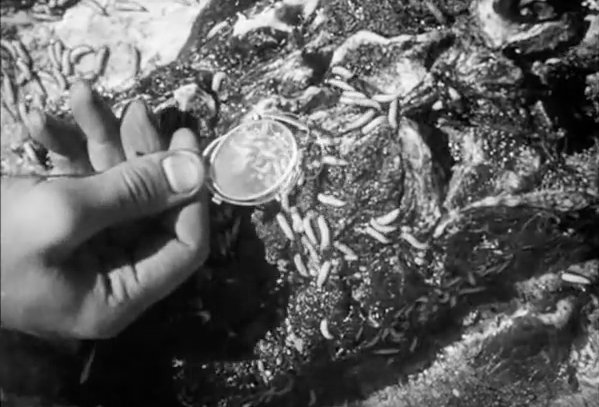
Alive maggots moving on meat. This is one of the most famous and shocking shots from «Battleship Potemkin».
- Drama on the Deck — dissatisfaction of sailors became known by battleship’s officers. The whole crew is lined up on the deck. A group of the most dissatisfied sailors is taken apart from others and is being covered with a wide canvas — these people are going to be shot away. Other sailors are rising a rebellion to save their mates. Finally they take over the ship, having been thrown their officers into the sea. But the one who raised the revolt is dead…
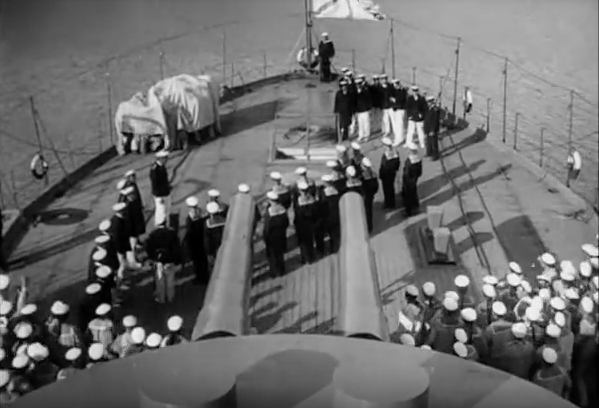
Sailors are going to be executed.
- A Dead Man Calls for Justice — …and his body is carried ashore by other sailors. People of Odessa city came to honor his memory. They support Potemkin’s crew and are going to mutiny too.
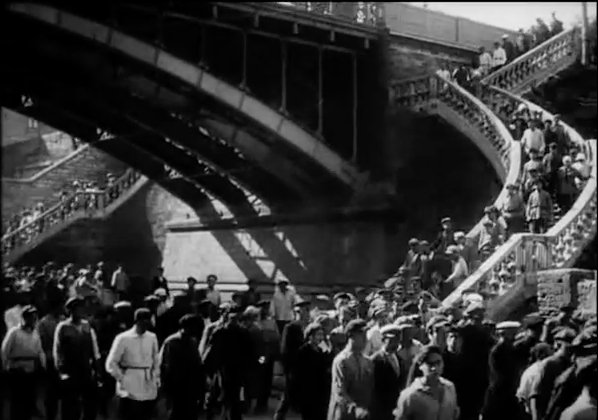
People of Odessa come to honor a memory of the dead sailor.
- The Odessa Steps — the most famous part of the film. Odessa’s govermet decides to crush the revolt and send Cossacks troops against rebellious citizens. A peaceful demonstration turns into a slaughter. After seeing a dozens of people killed, battleship’s crew opens fire against headquarters of Odessa’s generals.
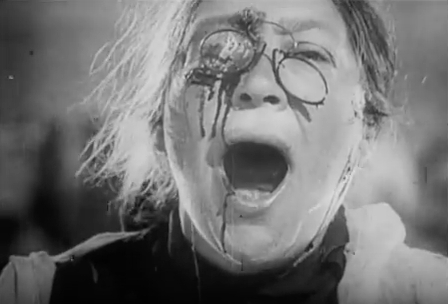
Woman suffered from police troops. Another famous and shocking shot from «Battleship Potyomkin».
- One Against All — After events of Odessa, the whole squadron is sent to destroy the rebellious battleship. Potyomkin’s crew decides to face the fight and approaches enemy ships. Potyomkin sends a signal to squadron’s sailors calling them on joining the revolt. Just a second separates battleship from a deadly fight. Suddenly — the word «brothers» appears on screen and sailors of imperial squadron are appearing on decks of their ships to greet a brave battleship. Guns remain silent. But the sound of fraternal «Hooray» flies above heads of tsar’s admirals. The battleship goes through squadron without a single shot.
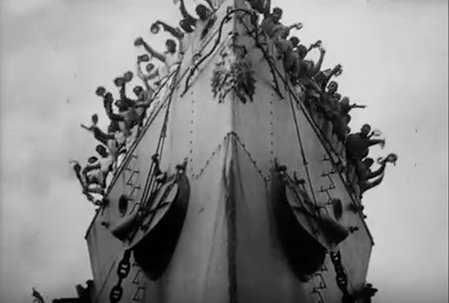
The final shot of «Battleship Potemkin» — battleship goes right onto a camera as a symbol of a forthcoming era.
Artistic features
Sergey Eisenstain provided the most innovative techniques of editing («montage») to create «Battleship Potyomkin». Some of its artistic solutions still remains actual. Eisenstein elaborates his own methods of film editing to gain a high degree of influence on audience. The director considers sequence of shots as a music score. Rhythm, tempo, emotional atmosphere, light, size, duration of each shot, the speed of filmed objects are considered as separate parties or themes like musical themes in a symphony. Each shot is placed in general sequence according to charateristics of above mentioned qualities. Eisenstein seeks to gain an accordance both inside each «party» and among different ones to create a harmonic and well-composed cinematic flow. As a result all «parties» or «themes» of each shot in sequence should move in the same direction to gain a required emotional and physiological effect.
Eisenstein operates with both emotional and physiological affects of a viewer. Before creating an emotional impact on audience he increases its physical tension and vice versa. A great example of such approach is the final scene where battleship goes against imperial squadron. The closer it approaches its enemy, the shorter are duration of each shot, the closer camera stands to objects, the faster is moving of each object in a frame. Increasing of visual rhythm invokes an increasing of physiological tension. Finally, when viewer’s physiological excitement reaches its culmination, Eisenstein strikes his audience emotionally. The final scene (fraternization among sailors of different ships) are emotional climax of physiological pumping.
The whole film is based on symphonic principles. Eisenstein changes expressive and lyrical parts during narration to let us rest and refresh our emotions. Meanwhile each following «action» scene is more expressive than the previous one. This way, changing action and lyrical scenes and making each following action scene more tense, affecting both our physiology and emotions by means of editing Eisenstein leads us to catharsis.
Visual examples
- Creating lyrical atmosphere through film editing. Picturesque morning landscapes of Odessa seaport are combined with images of the dead sailor:
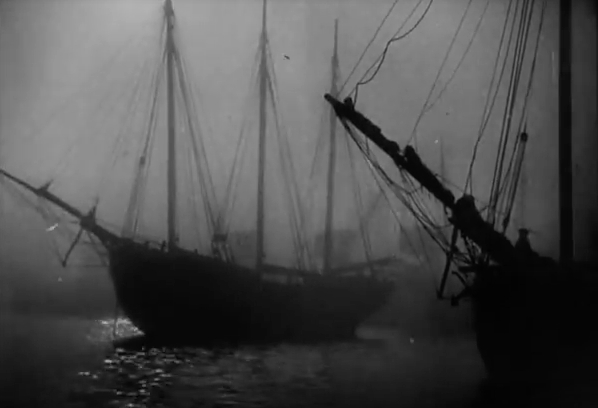
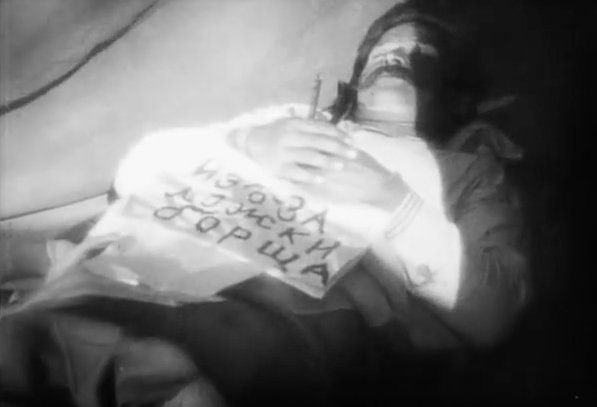
- Some shots of massacre in Odessa are made in quasi documentary style:
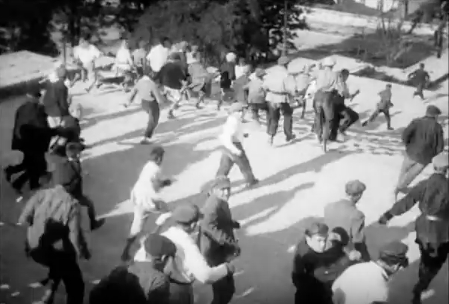
Meanwhile, this sequence is composed according to a strict rhythm of gendarmer's boots:
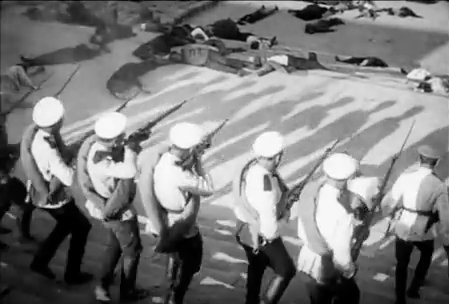
«Battleship Potyomkin» is created on state order. But it scarcely could be named a propaganda. It was supposed to be so, but Eisenstein’s vision and talent drove this film to the something more. First of all, this film doesn’t show any leader of rebellious ship. All members of the crew are the same organism — the ship seems to be a space of social garmonia. Propaganda is supposed to glorify the single leader, meanwhile there is no leadership among the sailors shown on screen. The key word of the film is «brothers». This word impelled a revolt — it was shouted out to prevent sailors execution in the begining. The same word prevented a sea-fight between Potyomkin and imperial squadron by making sailors of different ships fraternize instead of fighting each other. Thus the main idea of «Battleship Potemkin» is brotherhood.
The sailors of Eisenstein’s Potemkin doesn't take over enemy in war — they take over the war itself. That is why this film that was initiated as propagandistic turned out to be one of the most humanistic movies ever created.
***
P.S.: If you want to watch this film I advice you to find the copy restored by Deutsche Kinemathek – Museum für Film und Fernsehen (https://www.deutsche-kinemathek.de). This copy has the right soundtrack. Another copy restored in 1970-th in Soviet Union has Shostakovitch music overlaid. Shostakovitch is a great composer, but unfortunately his music doesn't reveal the spirit of this film.
P.P.S: According to wikipedia, the poster I used above is in public domain.
All screenshots are made on the official YouTube channel of «Mosfilm» studio
The film «Battleship Potyomkin» is in public domain.
@originalworks
Your Post Has Been Featured on @Resteemable!
Feature any Steemit post using resteemit.com!
How It Works:
1. Take Any Steemit URL
2. Erase
https://3. Type
reGet Featured Instantly – Featured Posts are voted every 2.4hrs
Join the Curation Team Here